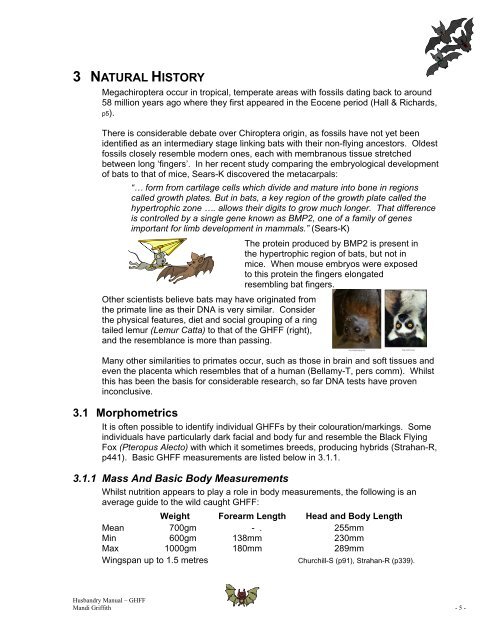Husbandry Manual for Grey- Headed Flying Fox - Nswfmpa.org
Husbandry Manual for Grey- Headed Flying Fox - Nswfmpa.org
Husbandry Manual for Grey- Headed Flying Fox - Nswfmpa.org
Create successful ePaper yourself
Turn your PDF publications into a flip-book with our unique Google optimized e-Paper software.
3 NATURAL HISTORY<br />
Megachiroptera occur in tropical, temperate areas with fossils dating back to around<br />
58 million years ago where they first appeared in the Eocene period (Hall & Richards,<br />
p5).<br />
There is considerable debate over Chiroptera origin, as fossils have not yet been<br />
identified as an intermediary stage linking bats with their non-flying ancestors. Oldest<br />
fossils closely resemble modern ones, each with membranous tissue stretched<br />
between long ‘fingers’. In her recent study comparing the embryological development<br />
of bats to that of mice, Sears-K discovered the metacarpals:<br />
“… <strong>for</strong>m from cartilage cells which divide and mature into bone in regions<br />
called growth plates. But in bats, a key region of the growth plate called the<br />
hypertrophic zone …. allows their digits to grow much longer. That difference<br />
is controlled by a single gene known as BMP2, one of a family of genes<br />
important <strong>for</strong> limb development in mammals.” (Sears-K)<br />
Other scientists believe bats may have originated from<br />
the primate line as their DNA is very similar. Consider<br />
the physical features, diet and social grouping of a ring<br />
tailed lemur (Lemur Catta) to that of the GHFF (right),<br />
and the resemblance is more than passing.<br />
The protein produced by BMP2 is present in<br />
the hypertrophic region of bats, but not in<br />
mice. When mouse embryos were exposed<br />
to this protein the fingers elongated<br />
resembling bat fingers.<br />
Many other similarities to primates occur, such as those in brain and soft tissues and<br />
even the placenta which resembles that of a human (Bellamy-T, pers comm). Whilst<br />
this has been the basis <strong>for</strong> considerable research, so far DNA tests have proven<br />
inconclusive.<br />
3.1 Morphometrics<br />
It is often possible to identify individual GHFFs by their colouration/markings. Some<br />
individuals have particularly dark facial and body fur and resemble the Black <strong>Flying</strong><br />
<strong>Fox</strong> (Pteropus Alecto) with which it sometimes breeds, producing hybrids (Strahan-R,<br />
p441). Basic GHFF measurements are listed below in 3.1.1.<br />
3.1.1 Mass And Basic Body Measurements<br />
Whilst nutrition appears to play a role in body measurements, the following is an<br />
average guide to the wild caught GHFF:<br />
Weight Forearm Length Head and Body Length<br />
Mean 700gm - . 255mm<br />
Min 600gm 138mm 230mm<br />
Max 1000gm 180mm 289mm<br />
Wingspan up to 1.5 metres Churchill-S (p91), Strahan-R (p339).<br />
<strong>Husbandry</strong> <strong>Manual</strong> – GHFF<br />
Mandi Griffith - 5 -

















